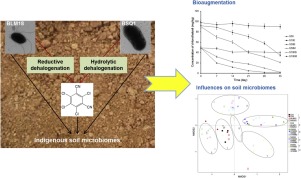Journal of Hazardous Materials ( IF 13.6 ) Pub Date : 2018-03-08 , DOI: 10.1016/j.jhazmat.2018.03.002 Xi-Hui Xu , Xiao-Mei Liu , Long Zhang , Yang Mu , Xu-Yuan Zhu , Jing-Ya Fang , Shun-Peng Li , Jian-Dong Jiang

|
Although bioaugmentation of pollutant-contaminated sites is a great concern, there are few reports on the relationships among indigenous microbial consortia, exogenous inocula, and pollutants in a bioaugmentation process. In this study, bioaugmentation with Pseudochrobactrum sp. BSQ1 and Massilia sp. BLM18, which can hydrolytically and reductively dehalogenate chlorothalonil (TPN), respectively, was studied for its ability to remove TPN from soil; the alteration of the soil microbial community during the bioaugmentation process was investigated. The results showed that TPN (50 mg/kg) was completely removed in both bioaugmentation treatments within 35 days with half-lives of 6.8 and 9.8 days for strains BSQ1 and BLM18 respectively. In high concentration of TPN-treated soils (100 mg/kg), the bioaugmentation with strains BSQ1 and BLM18 respectively reduced 76.7% and 62.0% of TPN within 35 days. The TPN treatment significantly decreased bacterial richness and diversity and improved the growth of bacteria related to the elimination of chlorinated organic pollutants. However, little influence on soil microbial community was observed for each inoculation treatment (without TPN treatment), showing that TPN treatment is the main force for the shift in indigenous consortia. This study provides insights into the effects of halogenated fungicide application and bioaugmentation on indigenous soil microbiomes.
中文翻译:

水解或还原脱卤菌株对百菌清污染土壤的生物强化作用及其对土壤微生物群落的影响
尽管对污染物污染场所的生物强化非常关注,但鲜有报道涉及生物强化过程中本地微生物菌群,外源接种物和污染物之间的关系。在这项研究中,假单胞菌属sp的生物增强。BSQ1和Massiliasp。研究了BLM18能够水解和还原脱氯百菌清(TPN)的能力,它具有从土壤中去除TPN的能力。研究了生物强化过程中土壤微生物群落的变化。结果表明,两种生物强化处理均在35天内完全清除了TPN(50 mg / kg),菌株BSQ1和BLM18的半衰期分别为6.8和9.8天。在高浓度的TPN处理土壤(100 mg / kg)中,菌株BSQ1和BLM18的生物强化作用在35天内分别降低了TPN的76.7%和62.0%。TPN处理显着降低了细菌的丰富度和多样性,并改善了与消除氯化有机污染物有关的细菌的生长。然而,每次接种处理(未使用TPN处理)对土壤微生物群落的影响均很小,这表明TPN处理是造成本地财团转移的主要力量。这项研究提供了对应用卤化杀真菌剂和生物强化对本地土壤微生物群落的影响的见解。



























 京公网安备 11010802027423号
京公网安备 11010802027423号